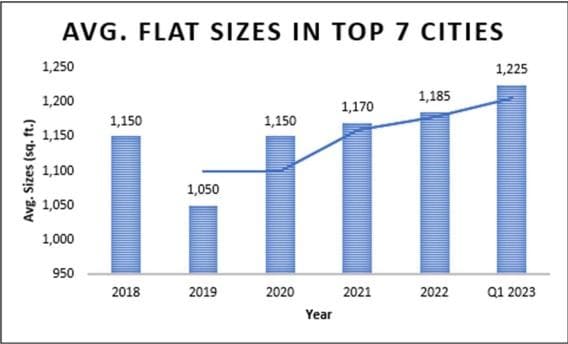Those living in the national capital are opting for bigger homes with the average flat sizes rising 50 per cent in Delhi-NCR to 1,700 square feet in the first quarter of 2023 from 1,130 square feet in the year-ago period. Developers in Delhi-NCR are closely tracking demand and launching bigger homes in this region, said property consulting firm Anarock.
“This is perhaps the first time in many years that there has been such an overwhelming demand for larger homes with 3 bedrooms. With more people working remotely, having a dedicated workspace at home has become a priority for many homebuyers, resulting in an increased demand for homes with additional rooms that can be converted into home offices or study rooms. Demand is also high for homes with large living rooms, bedrooms, and kitchens with extra features such as a yoga space and decks offering natural light and ventilation, among other things,” according to Ankush Kaul, Chief Business Officer, Ambience Group.
According to the report titled ‘The Housing Market Boom’ released at the 5th Edition of the CII Real Estate Confluence 2023 last month, out of a total of 4,662 survey participants, 42 per cent preferred 3BHKs while 40 per cent of them said that they preferred two-bedroom homes.
“Over 45 per cent of property seekers in the NCR are looking to buy 3BHK homes in the near future,” said the report.
The shift towards larger 3BHKs is not just restricted to South Delhi, but is also evident in Noida and Gurugram. With remote work likely to continue, the trend toward larger homes and suburban living is expected to persist in the future.
Delhi even pipped Mumbai in terms of the total number of houses sold over the last four years. In 2022, Delhi witnessed sales of 1.34 lakh units as against 74,943 houses sold in Mumbai, representing a significant increase of 78.8 percent in sales, according to a recent analysis by CRE Matrix Research.
NCR also saw the maximum new residential launches in the high-end segment accounting for 34% of supply in the city in the first quarter of 2023.
 Data provided by Anarock
Data provided by Anarock
Kolkata saw flat sizes increase by 44 percent — from a modest 800 sq ft in Q1FY2022 to 1,150 sq ft in Q1 FY2023. Hyderabad saw average flat size increase by 29 percent from approximately 1,700 sq ft in Q1FY2022 to approximately 2,200 sq ft in Q1FY2023.
Pune saw a 16 percent annual increase — from 877 sq ft in Q1FY2022 to 1,013 sq ft in Q1FY2023. Bengaluru saw an 8 percent yearly jump in average flat sizes – from approximately 1,200 sq ft in Q1FY2022 to approximately 1,300 sq ft in Q1 FY2023.
“Before Covid-19, apartment sizes were shrinking annually to meet the demand for compact homes prevalent then,” said Anuj Puri, chairman of Anarock.
“The central concerns were affordability and millennials’ preference for low-maintenance homes. 2020 saw an abrupt reversal of buyer preferences. With a sudden emphasis on the WFH and study-from-home culture, flat sizes began increasing for the first time in four years.”
In 2023, property prices are also heading north but the demand for bigger homes continues.
The first quarter of 2023 saw average apartment sizes in the top seven cities increase by approx. 7% since 2018, but those in Mumbai Metropolitan Region (MMR) and Chennai shrunk.
Chennai saw average flat sizes decrease by 6 percent — from approximately 1,250 sq ft in Q1FY2022 to approximately 1,175 sq ft in Q1FY2023.
MMR saw average flat sizes decrease by 5 percent – from approximately 783 sq ft in Q1FY2022 to approximately 743 sq ft in Q1 2023.
In the last five years, only 2020 saw average flat sizes in MMR see an annual rise of 21% against 2019. Since 2020, homes in the region are shrinking.
“The notable exceptions of MMR and Chennai are certainly interesting. A perception among developers that there is currently sufficient existing supply of larger format homes may be factor. Also, while MMR is hyper-expensive, Chennai is a very cost-sensitive market. In both instances, increasing the supply of smaller, more affordable homes makes sense,” said Puri.
 Data provided by Anarock
Data provided by Anarock Loan, Personal Loan, Home Loan, Business Loan,Loans in India Loan in India, Personal Loan, Home Loan, Business Loan, Loans in India,Loan Finance,Loan in India, Get Instant Personal Loan,Home Loan, Business Loans in India
Loan, Personal Loan, Home Loan, Business Loan,Loans in India Loan in India, Personal Loan, Home Loan, Business Loan, Loans in India,Loan Finance,Loan in India, Get Instant Personal Loan,Home Loan, Business Loans in India